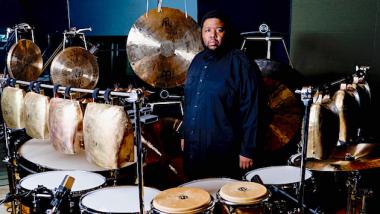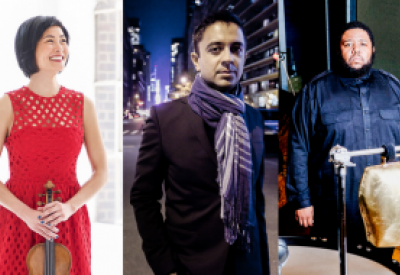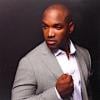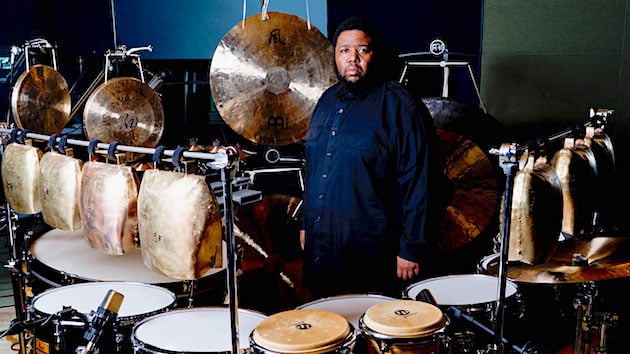
Multi-instrumentalist and composer Tyshawn Sorey is like R. Buckminster Fuller. The inventor widely known as the father of the geodesic dome once declared he was not a noun, but “a verb, an evolutionary process.” Sorey isn’t “a musician” or “a composer,” he is a man listening, chasing sounds, riding rhythms, swept forward on a perpetual, moving sonic and visual wavelength.
The Newark-born phenomenon praised for his instrumental chops — primarily as a virtuoso percussionist and drum-set player, but also as a pianist, trombonist, and more — displays parallel compositional acuity on his seven acclaimed recordings and in performances and festivals with his trio and other collaborators worldwide. With Vijay Iyer, he directed the Banff International Workshop in Jazz and Creative Music from 2013 on. He received a 2017 MacArthur Foundation award, is currently a professor of music at Wesleyan University, and composed Perle Noire: Meditations for Joséphine, a piece about the music and life of Josephine Baker, which he performed last January with soprano Julia Bullock at the Metropolitan Museum of Art in New York.
Building steam for an engagement in SF Performances’ Pivot Series in which he will appear Jan. 24 with violinist Jennifer Koh and pianist/composer Vijay Iyer, Sorey spoke about process, content, improvisation, collaboration, composing, and constantly seeking new voices of expression in himself and other people.
What are you listening to currently? Not just music, but anything that has drawn your attention.
I’m just so busy with work that I don’t get to listen to music as often as I’d like. When I do have time, I listen to a broad range. Listening to things other than music? Yeah. I’ve been listening out in North Dakota where my in-laws live, where I’ve been visiting. I listened to the nature. We had a big storm, very windy. Nature definitely plays a part in my compositional development. They have coyotes there and hearing coyotes howling in different intervals is influential. Whenever I’m composing, the last thing I want to listen to is other music. Of course, I’m influenced by all the music I’ve heard before, but also, I’m not afraid to be influenced by things other than music.
More than listening though, I’m a visual person. So the thing that’s interesting to me, in terms of the overall landscape of the city where my in-laws live, is that it’s very flat, pretty remote. I looked every day and there’s flatness and maybe a couple of farms and that’s all you see. What’s cool about that is how I start looking at how the sunlight reflects on the snow; how interesting the brightness came off to me. The sky and the sun, touching the snow, it’s all much brighter than you’d imagine it to be. That’s actually inspiring a piece for cello and orchestra I’m working on now. Seeing all the flatness, feeling the cold: I really like cold weather. The landscape is monochromatic and that’s interesting to me, although some people would think it’s monotonous. For me, you start to see different shades of white, with blues and other colors in it. I have synesthesia, of course, so you can say that informs my music as well.
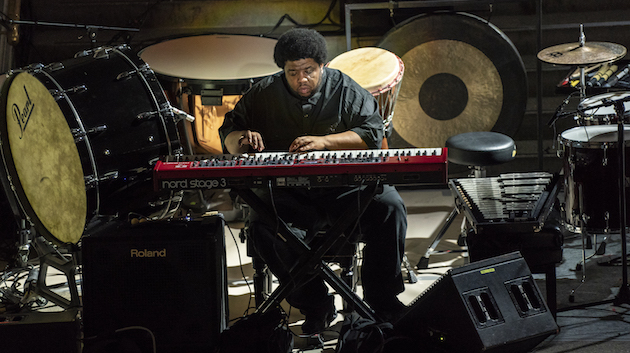
Will you talk about silence and simplicity and the role they play in your work? Do you believe those elements alter awareness of time, shapes, or overall form of a composition? Do you consider yourself a minimalist?
From an aesthetic point of view, I wouldn’t say I’m a minimalist. But there’s a lot of use of space and negative space in my music. Before I made my first recording, a lot of the problems I encountered with my music was I felt like it was leaning toward being much too complex. The quieter, softer music with more silence is what I was wanting to have in my music. But as an improviser, I was playing a lot of music that was rhythmically dense, really complex. Especially playing as a sideman — but that’s not to devalue what I’ve learned from those situations.
So I decided to turn in a different direction with my compositions. I liked the new directions so much, it became my vocabulary. Not just in my compositions, but in my performance practice. Like with my trio from when I formed it, that music was very different than what I was performing with other musicians. For instance, there were performances where I wouldn’t play for 45 minutes. I’d be onstage sitting there while the piano went on alone. We were deconstructing what the traditional piano trio is like.
When you’re in rehearsal, playing with other musicians or even in a performance, are you listening more as a composer or a musician? And when it’s the former, do you ever hear things that cause you to change the composition?
As a composer, when I’m rehearsing, sometimes the other musicians can inspire compositional changes. I was hearing the JACK Quartet play Everything Changes Nothing Changes [the work premiered in 2018 at Banff Centre for the Arts and Creativity].They played my music beautifully, but they knew it was based on numbers and they played it too mathematically. There was too much concern with the form. I went back and made changes to the score, with more of certain sections and less of certain sections. The results, after those revisions and other things, like slowing the tempo down, were what I wanted.
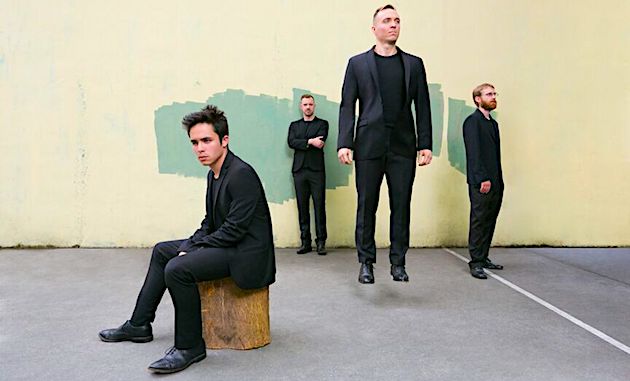
Lots of improvisers insist that skilled improvisation is the result of hard work: Do you agree?
Not really; for me it’s natural. When I’m rehearsing improvisation as a band leader, it’s slightly less hands on. I just try to put the musicians in the situation where their egos don’t belong. They just deal with the materials at hand: repetition, finding musical things that can be lessened or increased. I try to give them a wide platform, ranging from straight-ahead jazz to free improvisations. But they all have to be comfortable outside their ego: They have to think there is no “wrong.”
I can hear even in performance when people are stuck, thinking that whatever they’re going to play is wrong. To rectify that, composition helps. I retain a memory of the place improvisation works for them, then fix it into the compositional format. Like in my piano trio, when we first perform a composition, I don’t give guidance. But if there’s a part of the improvisation that maintains the energy, I go back and fix it into the composition. Rather than leave them to feel it will fail the second time, the players are drawn by the composition to use that fix when they play it a second time.
You know, part of that approach comes from working with inexperienced improvisers. How so? They tend to make the same mistakes. People tend to “follow.” One musician plays one thing and the other person plays it back exactly. I aim for the opposite: different types of response and no repeating back the same thing. Repeating the same thing doesn’t challenge the mind of the musician or the other music maker. It’s like a messed-up conversation that doesn’t get anywhere.
If working on the drum kit allows you to compose and establish a new work’s form, do other instruments you play introduce features the drums do not?
I actually do most of my composing on the piano. The piano provides other sounds. We think of attack as the defining point of music, but I think of decay. I’m interested in how the sound decays and how decay transforms the music for the listener. You hear the total sum of the music in that decay and you can investigate where that sonority comes from. If you get that sound right away, without time to characterize it, you miss the quality of making sound and its decaying. I try to get that resonance as a general concept. The drum kit — why I turn from the rhythmically dense sound of the instrument — is to get that resonance from the piano. I then look to how I can carry that out when playing the drum kit.
Is there an example of a time when a work transitioned or evolved during performance — becoming something other than what it had been as originally conceived and composed?
That happens. Movement, which is on my [2014] album, Alloy; it can go in so many different directions. It’s composed like a Brahmsian composition, but it’s also malleable in structure. It was originally conceived for solo piano and traditionally scored. But (pianist) Corey Smythe played it so well I wanted it in my trio.
In performance, we’d sometimes do only certain sections of it: not even the whole piece. Or we’d be playing the score in a show and I’d tell them to play a certain section backwards. I’d point with my right hand in the opposite direction as a signal to read the music backwards. Or sometimes, I’d signal that they’d read and play each measure backwards, but the music would go forward in order, as written. Other times we’d go from section A and transition to section C without going through section B. It necessitates spontaneous invention when we do that. It’s still traditionally notated and scored on a classical model, but we transform it on the spot.
What’s the benefit of that approach, other than to keep it alive for the musicians?
The piece now has so many identities, which is what I wanted. If people think it’s crazy, that’s fine. But for me, I like to keep things fresh. I want a piece of music to live, but also to grow, to take on maturity. One situation can then expand a piece into something different, to a place where I couldn’t imagine it before.
How do you approach collaboration and what defines a “good” collaboration?
It’s actually something that comes easy to me. What I’ve recognized as a band leader is that it’s a part of my compositional practice. Deciding who you’re going to work with is compositional. Music is made with people and hopefully, can inspire people in ways that are real. You have the identity of multiple voices as opposed to just one person. Also, it brings affinity for artists who are thinking differently, but also in like-minded ways. Community is what I’m interested in establishing; finding ways of respecting each other’s differences. It’s central to my work.
What goes into it is researching who I want to work with. Once I understand what they do and don’t do, I try to involve them in things that they like to do, but also things that will challenge them.
Have you experienced collaborations that despite your research and best intentions, don’t end with best results? What viewpoint do you take when that happens?
Sure. I’ve had some that failed. I’ve said, ok, this situation doesn’t work for me so do I want to write music out of it? Do I take the ideas and work them out with others? Sometimes I learn more about the kind of research I have to do about people before collaborating. I realize those failures are opportunities to strengthen what I want to do as a composer. I like to keep pushing myself.
Without naming names, will you describe an example of what you learned from a “failed” collaboration?
I learned a composition of mine can go too long. My pieces tend to go long, but a piece I wrote about 10 years ago, I recorded. It was about a four-hour composition. It was performed in a venue with very uncomfortable chairs. We did the piece and only a handful of people stayed throughout. I realized when I listened to the recording later that there were parts of the piece that were limited. It was not actually that I thought the piece was too long, I just felt I didn’t get much out of it. And also, it was performed in this place — it was an actual gym, yeah, a gym — very tense, not an environment conducive to this music. I started to write shorter works: still long, but not three-to-four hours long. I also started to think about the space — the where or when a piece is going to be performed. That can completely impact the way music is heard.
What can you say about the SF Performance Project with (violinist) Jennifer Koh and (composer-pianist) Vijay Iyer?
My piece and Vijay’s piece are on the program. The program was designed originally with another piece in the middle of my and Vijay’s piece. Jenny performed that other composer’s set after mine, then Vijay and I improvised for 10 minutes leading into his piece. We won’t do the other piece but we’ll still do the improvising into Vijay’s.
My composition was written for violin and glockenspiel, but since not a lot of people have those, I came up with an alternate composition with piano. It’s short, about seven-to-eight minutes, very quiet and also very high in the cello register. There’s an ABA form, with A and its repeat very chromatic — with blues elements attached to the end. The B section is more modal. Vijay’s piece has some improvisation in it: there’s none in mine. His piece goes through electronic type things, counterpoint, spaces that are very dark. There’s more diverse activity in his piece where mine has a stream of consciousness flow.
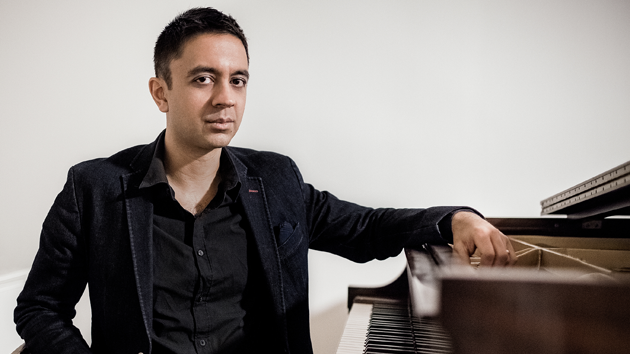
If you had time for exploration, what soundscapes would you seek, and would you travel to hear them in their place of origin, in the culture of that music?
The music of West Africa, of Ghana, Togo, and Benin, specifically. That music speaks to me in a profound way. And yes, even though I’ve studied the West African drumming and culture, how one hears that music changes depending on how you hear it. I’m interested in how many different ways you can hear rhythm and how it impacts the dance: how they tie together in historical lineage is interesting to me.
The second place would be Tibet. I’m interested in Tibetan rituals and the music that comes from that: the feeling of austerity. One can listen on the internet and picture the dark cloud of sound, the chanting and bells played in these ceremonies, but to experience them in real time, on a human level, it’s different.
Will you say a few things about Cycles Of My Being and adding voice and messaging to your compositions?
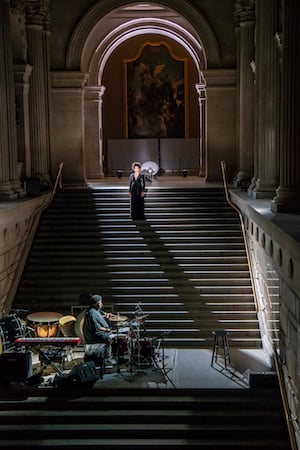
After a Joséphine Baker project I thought was going to be the last thing I wrote for voice, I was asked to do Cycles of My Being. I took from the Baker experience and applied it to blacks in positions of powerlessness — to black people getting into zones that are not all that healthy. I wanted to deal specifically with black males and the precariousness of what that means. In writing it, I found I’d like to write more pieces that deal with real life issues. At least in my vocal works, I want to get deeper inside the African American experience and touch on elements we can relate to. But not do something that’s commercialized. I’m interested in making humans really think about the situation. About the perils we experience; dealt with in an artful way that brings out hope. I want to write music that other people can perform so that other black men feel they have a voice. I want them to sing this music and not have it be just one person singing about what’s going on.

